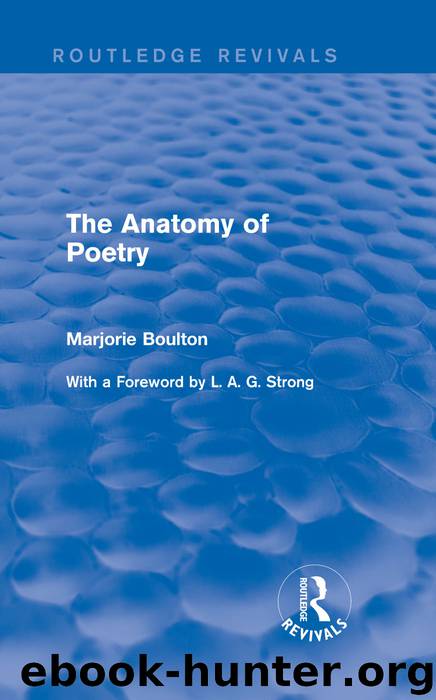The Anatomy of Poetry (Routledge Revivals) by Boulton Marjorie

Author:Boulton, Marjorie.
Language: eng
Format: epub
ISBN: 978-1-317-93649-7
Publisher: Taylor & Francis (CAM)
1 The reader of poetry should dismiss all such inappropriate associations. The teacher, however, has to watch for them!
1 Louis MacNeice successfully used many words such as peanuts, pretzels, beer, clams, queues, in his fine ironical poem Bar-Room Matins.
1 Not always intellectually, in the sense that the poem can be paraphrased word-for-word; the morning-bright Apollo forbid so narrow an idea of ‘understanding’!
XIV INTELLECTUAL FORM
THE TWO MAIN PATTERNS OF IMAGERY
All garlanded with carven imag’ries
KEATS: Eve of St Agnes
In general a poem may have a series of images that support or contradict one another, or a single dominant image on which the sequence and structure of the poem depend. Burns’s A Red, Red Rose expresses passionate love by a series of simple and beautiful hyperboles; his effect is achieved by an accumulation of images that are not closely related to one another.1
O my luve is like a red, red rose,
That’s newly sprung in June;
O my luve is like the melodie,
That’s sweetly play’d in tune.
As fair art thou, my bonnie lass,
So deep in luve am I;
And I will luve thee still, my dear,
Till a’ the seas gang dry.
Till a’ the seas gang dry, my dear,
And the rocks melt wi’ the sun;
And I will love thee still, my dear,
While the sand o’ life shall run.
And fare-thee-weel, my only luve!
And fare-thee-weel awhile!
And I will come again, my luve,
Though it were ten thousand mile.
Collections of unrelated images may also be found in Nashe’s Adieu;farewell Earth’s bliss, Crashaw’s Wishes for the Supposed Mistress, and Shelley’s When the Lamp is Shattered.
Another type of poenl, which makes a very different impression on the mind, uses a single central, dominant image and builds the whole structure of the poem around it. In George Herbert’s Love the experience of divine love is shown as the shy attendance of a consciously unworthy guest at a feast:
Love bade me welcome; yet Iny soul drew back,
Guilty ofdust and sin.
But quick-eyed Love, observing me grow slack
From my first entrance in,
Drew nearer to me, sweetly questioning
If I lacked anything.
A guest, I answered, worthy to be here.
Love said, You shall be he.
I, the unkind, ungrateful? Ah, my dear,
I cannot look on thee.
Love took my hand and smiling made reply,
Who made the eyes but I?
Truth, Lord, but I have marred them; let my shame
Go where it doth deserve.
And know you not, says Love, who bore the blame?
My dear, then I will serve.
You must sit down, said Love, and taste my meat.
So I did sit and eat.
This is, in a sense, a small allegory, though the term is more often given to a larger piece of work. Clearly, here, Love is Divine Love, probably Christ as Redeemer, and the unworthy guest is George Herbert, aware of his sins; but we need not try to find allegorical meanings for the taking of the hand or the making of the eyes; “twere to consider too curiously, to consider so.’ It is possible that the poem refers to the actual partaking of the Holy Communion, but it might equally well be a poem about some other mystical experience of God outside orthodox ritual.
Download
This site does not store any files on its server. We only index and link to content provided by other sites. Please contact the content providers to delete copyright contents if any and email us, we'll remove relevant links or contents immediately.
4 3 2 1: A Novel by Paul Auster(12289)
The handmaid's tale by Margaret Atwood(7681)
Giovanni's Room by James Baldwin(7197)
Asking the Right Questions: A Guide to Critical Thinking by M. Neil Browne & Stuart M. Keeley(5649)
Big Magic: Creative Living Beyond Fear by Elizabeth Gilbert(5615)
Ego Is the Enemy by Ryan Holiday(5295)
The Body: A Guide for Occupants by Bill Bryson(4976)
On Writing A Memoir of the Craft by Stephen King(4863)
Ken Follett - World without end by Ken Follett(4646)
Adulting by Kelly Williams Brown(4488)
Bluets by Maggie Nelson(4476)
Eat That Frog! by Brian Tracy(4436)
Guilty Pleasures by Laurell K Hamilton(4362)
The Poetry of Pablo Neruda by Pablo Neruda(4041)
Alive: The Story of the Andes Survivors by Piers Paul Read(3970)
White Noise - A Novel by Don DeLillo(3955)
Fingerprints of the Gods by Graham Hancock(3943)
The Book of Joy by Dalai Lama(3903)
The Bookshop by Penelope Fitzgerald(3777)
